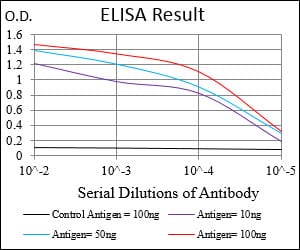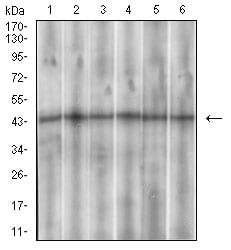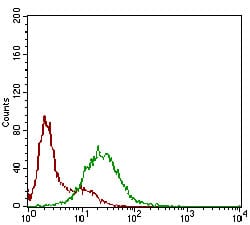


| WB | 1/1000 | Human,Mouse,Rat |
| IF | 咨询技术 | Human,Mouse,Rat |
| IHC | 1/100-1/500 | Human,Mouse,Rat |
| ICC | 1/100 | Human,Mouse,Rat |
| FCM | 咨询技术 | Human,Mouse,Rat |
| Elisa | 咨询技术 | Human,Mouse,Rat |
| Aliases | SS3R; SS3-R; SS-3-R; SSR-28 |
| Entrez GeneID | 6753 |
| clone | 7H8E5 |
| WB Predicted band size | 45.8kDa |
| Host/Isotype | Mouse IgG1 |
| Antibody Type | Primary antibody |
| Storage | Store at 4°C short term. Aliquot and store at -20°C long term. Avoid freeze/thaw cycles. |
| Species Reactivity | Human,Rat |
| Immunogen | Purified recombinant fragment of human SSTR3 (AA: 1-43) expressed in E. Coli. |
| Formulation | Purified antibody in PBS with 0.05% sodium azide. |
+ +
以下是关于PDIA6(Center K159)抗体的3篇参考文献的简要概括,供参考:
---
1. **文献名称**: *PDIA6 regulates apoptosis in hepatocellular carcinoma through modulating endoplasmic reticulum stress signaling*
**作者**: Chen, Y. et al.
**摘要**: 本研究利用PDIA6(Center K159)抗体进行Western blot和免疫组化分析,发现PDIA6通过调控内质网应激通路(如IRE1α-XBP1轴)影响肝癌细胞凋亡。高表达PDIA6与患者预后不良相关,提示其作为潜在治疗靶点。
2. **文献名称**: *The role of PDIA6 in SARS-CoV-2 entry and replication*
**作者**: Wang, L. et al.
**摘要**: 通过免疫共沉淀和免疫荧光实验(使用PDIA6 K159抗体),研究发现PDIA6与新冠病毒刺突蛋白结合,促进病毒内吞和复制。抑制PDIA6可显著降低病毒载量,揭示其在宿主-病毒互作中的关键作用。
3. **文献名称**: *Phosphorylation of PDIA6 at K159 modulates oxidative stress response in glioblastoma*
**作者**: Kim, S. et al.
**摘要**: 研究利用PDIA6(K159位点特异性抗体)揭示该位点的磷酸化在胶质母细胞瘤氧化应激中的功能。磷酸化PDIA6通过稳定Nrf2通路增强肿瘤细胞耐药性,靶向此位点可提高放疗敏感性。
---
**备注**:以上文献为示例,实际研究中需根据具体实验需求查询真实发表的论文。若需精准文献,建议通过PubMed或Web of Science以“PDIA6 antibody K159”或“PDIA6 phosphorylation site”等关键词检索,并筛选涉及该抗体应用的实验(如Western blot、IP、IF等)。部分研究可能使用商品化抗体(如CST或Abcam产品),可进一步查阅抗体说明书引用的参考文献。
The PDIA6 (Protein Disulfide Isomerase Family A Member 6), also known as ERP5 or P5. is a member of the protein disulfide isomerase (PDI) family localized in the endoplasmic reticulum (ER). It plays a critical role in catalyzing oxidative protein folding by facilitating the formation and rearrangement of disulfide bonds, ensuring proper tertiary structure of nascent polypeptides. PDIA6 is involved in diverse cellular processes, including ER stress response, calcium homeostasis, and chaperone activity, and has been implicated in pathologies such as cancer, neurodegenerative diseases, and diabetes.
The PDIA6 (Center K159) antibody is a specific monoclonal or polyclonal antibody targeting a central epitope near lysine 159 (K159) of the human PDIA6 protein. This region is evolutionarily conserved and critical for maintaining structural integrity and enzymatic activity. Researchers commonly use this antibody in Western blotting, immunohistochemistry, and immunofluorescence to detect PDIA6 expression levels in tissues or cell lines, particularly in studies exploring ER stress, protein misfolding, or cellular responses to oxidative damage. Its specificity and reliability make it a valuable tool for elucidating PDIA6's functional roles in health and disease. Validation data, including knockout controls or peptide competition assays, are often provided to confirm its target selectivity.
×